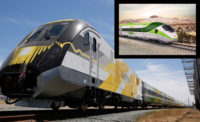Viewpoint: The American Infrastructure
Ancient Contracting Methods Will Lead to Costly Construction Boondoggles

A construction worker cuts stone at an entrance to New York City's $4.5-billion Second-Avenue subway line, which opened its first phase in 2017. Its next phase, estimated at more than $6 billion, now is underway. Photo: AP/Seth Wenig
In an age when image recognition, Big Data analysis and artificial intelligence are coming to define construction, outdated and inefficient contracting and construction management practices won’t cut it to build critical infrastructure projects at the scale and speed they’re now needed.
Innovative methods such as public-private partnerships and integrated project delivery already are proving their value globally to fast-track construction and avoid costly errors from poor planning and management.
Political leaders must adopt such approaches pronto if there’s any hope to upgrade U.S. infrastructure before it deteriorates beyond any realistic cost and schedule framework. ASCE’s D+ grade for U.S. infrastructure in 2017 was the same as it was in 2013!
While new-age technology is at more jobsites, contract terms and project-delivery methods used by most U.S. public agencies are stuck in the early 20th century.
Stubborn reliance on design-bid-build as the only method for most public works is at the core of the problem, with contract award going only to the lowest responsible, responsive bidder. Initial cost estimates and schedules—and contractor bids—usually include big contingencies (20% or more) to account for archaic contract terms and conditions, and expected bureaucracy. This has led most major public projects to finish late and with big cost overruns.
Modern project control tools more accurately track progress and deviations, allowing construction managers to make more timely corrections.
Results have improved as more states have unleashed agencies to use design-build, as Colorado has since the late 1990s.
The award-winning $1.67-billion Transportation Expansion (T-REX) Interstate in Denver finished in 2006, 3.2% under budget and 22 months early.
The “partnering agreement” among public agencies ensured all were aligned with project goals. Its success led to the $2.2-billion East and Gold Line Enterprise (Eagle) P3 approach as part of the city’s FasTracks program. The Eagle P3 procurement, from concept to contract, was done in three years.
At the recent conference of the Design-Build Institute of America, Richard Thomas, its director of state and local legislative affairs, said “almost every owner that has used DB wants to use it again,” according to ENR.
Even so, states face looming DB sunset provisions or other legislative hurdles to extend programs.
Modern project control tools more accurately track progress and deviations, allowing construction managers to make more timely corrections.
There is little room for fraud and abuse when updated practices with proven track records are properly used. Checks and balances, as well as fair risk allocation, must be built into delivery models.
Megaprojects such as the estimated $30-billion Gateway transit upgrade between New York and New Jersey and the $6-billion next phase of Manhattan’s Second Avenue Subway are already touted as costly boondoggles. We must reimagine U.S. contracting so industry can deliver these in a time frame and cost structure that no longer is a global joke. What can we learn from successes in other countries? Construction management tools such as IPD contracts that allow full life-cycle cost analysis worked well for major projects such as London’s $10-billion-plus Crossrail.
When so many large capital projects fail, we must ask what in the process doesn’t work anymore? Where are savings that must be reinvested in other badly needed infrastructure? How long before impacts from major initiatives delayed, canceled or postponed indefinitely show up in the U.S. and regional economies?
As a start, let’s break up multibillion-dollar, long-term programs such as the proposed Penn Station reconstruction and Gateway into manageable segments and phase them based on priorities of existing conditions.
The definition of insanity is to expect a different outcome while you keep doing the same thing! The Trump administration should push change by requiring new contracting methods in its touted infrastructure program. But whether or not promises turn to funding, state and local officials must step up, as they have on other issues, sooner rather than later.
Mysore Nagaraja, consultant and former MTA Capital Construction president, can be reached at consultmysore@yahoo.com; Howard Sackel, senior VP of Paco Technologies and former ARC Tunnel project director for the Port Authority of NY and NJ, is at hsackel@pacogroup.com; Bob Previdi, policy coordinator of the Bicycle Coalition of Greater Philadelphia and former NYC Transit planner, is at bob@bicyclecoalition.org.
If you have an idea for a column, please contact Viewpoint Editor Richard Korman at kormanr@enr.com.



